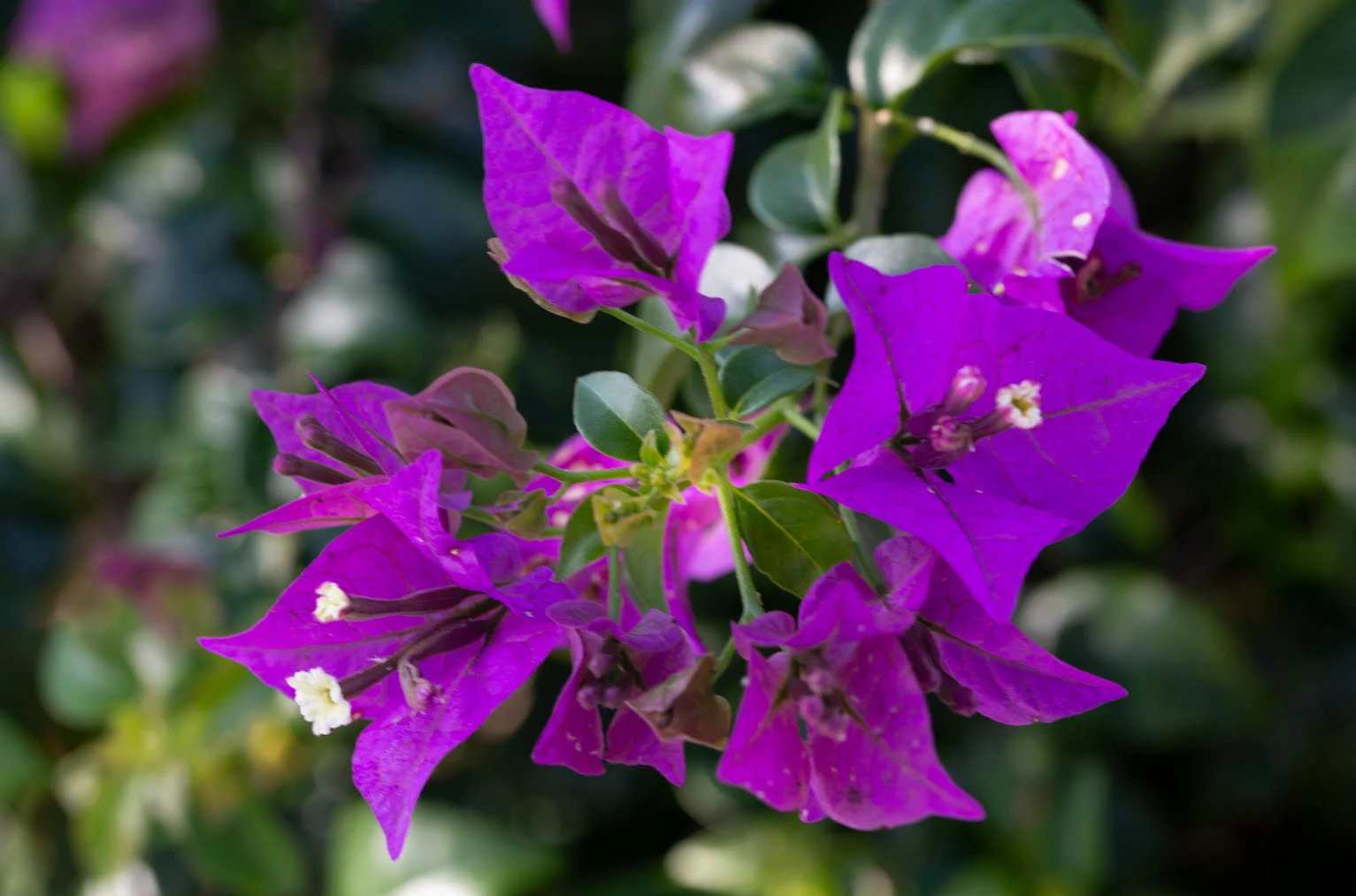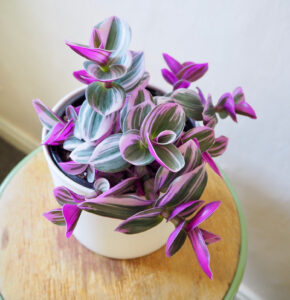Bougainvillea is a vibrant and hardy flowering plant known for its striking colors and dramatic blossoms. The purple variety, with its brilliant magenta-purple bracts, is particularly eye-catching and a favorite for gardeners looking to add a burst of color to their landscapes. Bougainvillea is often grown as a vine or shrub and is perfect for creating lush, tropical-looking spaces, whether in hanging baskets, along fences, or as a standalone specimen.
Overview
- Botanical Name: Bougainvillea spp.
- Common Name: Bougainvillea
- Color: Purple, though some cultivars may show varying shades of magenta, violet, or fuchsia.
- Plant Type: Evergreen shrub or vine (depending on climate and pruning)
- Height: 3 to 40 feet (varies depending on variety and growth habit)
- Spread: 3 to 15 feet (can be controlled with pruning)
- Hardiness Zones: USDA 9–11 (generally tropical or subtropical)
- Sunlight: Full sun
- Soil: Well-draining, moderately fertile
- Watering: Drought-tolerant once established, but requires regular watering in its early growth stages
- Bloom Time: Spring through fall (year-round in frost-free zones)
Planting Bougainvillea
When to Plant
- Best time: In warm months—spring or early summer when temperatures are consistently above 60°F (15°C).
- Avoid planting in the winter, as it may not have enough time to establish before cold weather sets in.
Where to Plant
- Sunlight: Bougainvillea thrives in full sun, meaning it needs at least 6 hours of direct sunlight each day to bloom profusely. Without enough sunlight, the plant may not bloom as freely and may develop sparse foliage.
- Soil: Well-draining soil is crucial for bougainvillea’s health. It does best in sandy or loamy soil with good drainage. Heavy, clayey, or waterlogged soil can cause root rot. A slightly acidic to neutral pH (6.0–7.5) is ideal.
- Location: Bougainvillea is excellent for walls, fences, trellises, and pergolas. It can also be planted in containers if you want to control its growth or move it indoors for the winter.
Spacing
- Plant bougainvillea at least 3–4 feet apart if you’re planting multiple plants or growing it as a hedge. If growing it as a vine, provide enough space for the plant to spread and climb.
Caring for Purple Bougainvillea
Watering
- Young plants: Water regularly to keep the soil consistently moist but not soggy. Water deeply to encourage strong root development.
- Established plants: Once established, bougainvillea is drought-tolerant and prefers to dry out between waterings. Water deeply but allow the soil to dry out completely before watering again.
- Avoid overwatering: Bougainvillea dislikes wet roots, and overwatering can lead to root rot, especially in poorly draining soil.
Fertilizing
- During the growing season (spring and summer): Bougainvillea benefits from light feeding every 4–6 weeks with a balanced fertilizer that is low in nitrogen. Too much nitrogen can encourage foliage growth over blooms.
- Winter: Reduce fertilization or stop entirely during the dormant months.
- Organic options: Compost or a slow-release granular fertilizer can also be used to provide nutrients throughout the growing season.
Pruning
- Bougainvillea can become quite vigorous, so regular pruning is important to keep it manageable and encourage more blooms.
- When to prune: Prune after the main flowering cycle, which is typically after the plant has finished blooming for the season (late summer or fall). You can also lightly trim the plant in the spring if it is becoming too unruly.
- How to prune: Use clean, sharp pruning shears to remove dead or damaged wood. Cut back leggy stems or ones that have finished blooming to promote new growth. When grown as a vine, prune to control its direction of growth, especially if it’s climbing walls or trellises.
Support for Climbing Varieties
- Bougainvillea vines need support to climb. Provide a sturdy trellis, fence, or arbor for the vine to latch onto. Ensure that the support structure can handle the plant’s weight as it grows.
Common Problems and Troubleshooting
Bougainvillea is relatively low-maintenance, but like any plant, it may encounter a few issues.
| Problem | Cause | Solution |
|---|---|---|
| No flowers | Insufficient sunlight, too much nitrogen, overwatering | Ensure the plant gets 6–8 hours of sun per day, avoid overfertilizing with nitrogen-rich fertilizers, and allow the plant to dry out between waterings. |
| Yellowing leaves | Overwatering, poor drainage, or nutrient imbalance | Check soil drainage, reduce watering, and ensure the plant is not in standing water. Consider using a fertilizer that is balanced or specifically formulated for bougainvillea. |
| Leaf drop | Sudden temperature changes, stress from pests, or too much water | Protect the plant from frost, and make sure it’s not exposed to drafts or extremes in temperature. Reduce watering and check for pests. |
| Pests | Aphids, scale, or mealybugs | Use insecticidal soap or neem oil to treat affected areas, or rinse the plant with a strong jet of water to remove pests. |
Winter Care
Bougainvillea is not frost-tolerant, and cold temperatures can severely damage the plant. If you live in a region with cold winters, take these steps to protect your plant:
- In containers: Bring the plant indoors before the first frost. Place it in a sunny spot and continue to water sparingly. Bougainvillea will often shed leaves when moved indoors but may regrow them in spring.
- In-ground plants: In USDA zones 9–11, bougainvillea should survive the winter outdoors. However, in colder zones, you may need to cover the plant with frost cloth or provide a protective mulch layer around the roots. If possible, bring the plant into a sheltered area.
Propagation
Bougainvillea is easily propagated from cuttings. Here’s how you can propagate a new purple bougainvillea plant:
- Take a cutting: Choose a healthy, mature stem and cut it about 6–8 inches long, making the cut just below a leaf node.
- Remove leaves: Strip off the lower leaves to expose the bare stem.
- Rooting hormone (optional): Dip the cut end in rooting hormone to encourage root development.
- Planting the cutting: Place the cutting in a small pot filled with a well-draining potting mix (such as a mix of sand and peat).
- Water and wait: Keep the cutting in a warm, sunny location and water lightly. In a few weeks, the cutting should begin to root and can be transplanted into a larger pot or garden bed.
Uses for Purple Bougainvillea
- Landscaping: Bougainvillea is often used as a stunning ground cover, climbing vine, or shrub to enhance fences, walls, and trellises.
- Container planting: It can thrive in pots, hanging baskets, or containers on patios and balconies.
- Cut flowers: The vibrant bracts make bougainvillea a striking addition to floral arrangements, although they are not true flowers (the small white flowers inside the bracts are the actual flowers).
- Wildlife: Bougainvillea attracts pollinators such as bees, butterflies, and hummingbirds, making it an excellent choice for pollinator-friendly gardens.
Summary Care Table
| Care Task | Details |
|---|---|
| Light | Full sun (6+ hours daily) |
| Watering | Deep watering, allow soil to dry out between waterings |
| Soil | Well-draining, moderately fertile |
| Fertilizing | Light feeding with low-nitrogen fertilizer in spring/summer |
| Pruning | Prune after flowering, shape to control size |
| Winter care | Protect from frost, move indoors in colder zones |
| Pests | Aphids, scale, mealybugs (treat with neem oil or insecticidal soap) |
Final Thoughts
Purple bougainvillea is an eye-catching and resilient plant that can thrive in a variety of settings, adding a dramatic touch of color to gardens, walls, and patios. By providing it with the right amount of sunlight, water, and care, you can enjoy its vibrant blooms year after year. Whether you’re growing it as a vine to cover fences or trellises, or as a compact shrub, bougainvillea is sure to impress.


